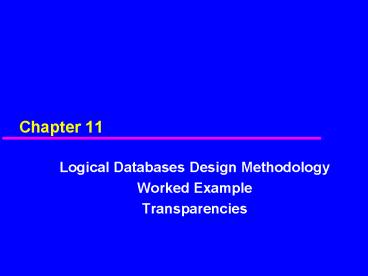Logical Databases Design Methodology - PowerPoint PPT Presentation
1 / 21
Title:
Logical Databases Design Methodology
Description:
Removing recursive Supervises and Supports relationships. 4 ... Merging the Advert entities from Supervisor's and Manager's views. 11 ... – PowerPoint PPT presentation
Number of Views:23
Avg rating:3.0/5.0
Title: Logical Databases Design Methodology
1
Chapter 11
- Logical Databases Design Methodology
- Worked Example
- Transparencies
2
Removing Client Views Property_for_Rent (MN)
relationship
2
3
Removing recursive Supervises and Supports
relationships
3
4
Supervisor's local logical data model (Version 1)
4
5
Supervisor's local logical data model displaying
the transactions supported
5
6
Step 2.5 Draw Supervisor's local logical data
model (Final Version)
6
7
Comparison of entities and their primary keys in
Supervisors and Managers views
7
8
Comparison of relationships in Supervisors and
Managers views
8
9
Merging the Staff entities from Supervisor's and
Manager's views
9
10
Merging the Advert entities from Supervisor's and
Manager's views
10
11
Step 3.4 Draw Global logical data model of
DreamHome case study
11
12
Chapter 11 - Objectives
- How to use the logical database design
methodology, described in Chapter 8. - How to use this methodology to create a logical
database design for the DreamHome case study.
12
13
Step 2.1 Map local conceptual data model to
local logical data model
- (1) Remove MN relationships.
- (2) Remove complex relationships.
- (3) Remove recursive relationships.
- (4) Remove relationships with attributes.
- (5) Remove multi-valued attributes
- (6) Re-examine 11 relationships.
- (7) Remove redundant relationships.
13
14
Step 2.2 Derive relations from local logical
data model
- To represent entities and relationships described
in Supervisors view of DreamHome. - For example, the composition of Viewing relation
is - Viewing (Property_No, Client_No, Date_View,
Comments) - Primary Key Property_No, Client_No, Date_View
- Foreign Key Property_No references
Property_for_Rent(Property_No) - Foreign Key Client_No references
Client(Client_No)
14
15
Step 2.3 Validate model using normalization
- First Normal Form (1NF) - removes repeating
groups - Second Normal Form (2NF) - removes partial
dependencies on the primary key - Third Normal Form (3NF) - removes transitive
dependencies on the primary key - BoyceCodd Normal Form (BCNF) - removes remaining
anomalies from all functional dependencies.
15
16
Step 2.4 Validate model against user
transactions
- We can ensure that the information (entities,
relationships, and attributes) required by each
transaction is supported by the model by
providing a description of how we may achieve the
transaction. - We can diagrammatically representing each
transaction on the Supervisors local logical
data model.
16
17
Step 2.6 Define integrity constraints
- Required data
- Attribute domain constraints
- Entity integrity
- Referential integrity
- Enterprise constraints
17
18
Step 3.1 Merge local logical data models into
global model
- (1) Review the names of entities and their
primary keys. - (2) Review the names of relationships.
- (3) Merge entities from the local views.
- (4) Include (without merging) entities unique
to each local view. - (5) Merge relationships from the local views.
- (6) Include (without merging) relationships
unique to each local view. - (7) Check for missing entities and
relationships. - (8) Check foreign keys.
- (9) Check integrity constraints.
- (10) Draw the global logical data model.
- (11) Update the documentation.
18
19
Step 3.2 Validate global logical data model
- Although validated the Supervisors and Managers
data models before building global logical data
model - we may have introduced errors during the
process of merging the data models. - Very important to validate the global logical
data model using the rules of normalization and
against the required transactions.
19
20
Step 3.3 Check for future growth
- Important global logical data model is capable of
being extended at a later stage as the users
requirements change.
20
21
Step 3.5 Review global logical data model with
users
- Important to review global logical data model
with users of each view. If the model contains
any errors we must repeat the appropriate step(s)
in the methodology. - Process of review is repeated until all the users
are satisfied with the global logical data model. - When data model is signed off by the users, we
proceed to physical design of the database.
21































